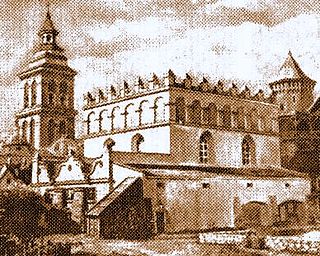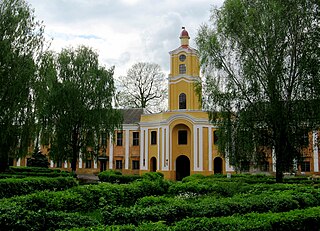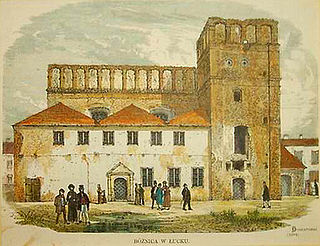
Przemyśl is a city in southeastern Poland with 58,721 inhabitants, as of December 2021. In 1999, it became part of the Subcarpathian Voivodeship; it was previously the capital of Przemyśl Voivodeship.

Brody is a city in Zolochiv Raion, Lviv Oblast, western Ukraine. It is located in the valley of the upper Styr River, approximately 90 kilometres northeast of the oblast capital, Lviv. Brody hosts the administration of Brody urban hromada, one of the hromadas of Ukraine. Population: 23,134.

Olyka is an urban-type settlement in Lutsk Raion, Volyn Oblast, western Ukraine. It is located east of Lutsk on the Putylivka Rriver. Its population is 3,032.

Synagogue architecture often follows styles in vogue at the place and time of construction. There is no set blueprint for synagogues and the architectural shapes and interior designs of synagogues vary greatly. According to tradition, the Shekhinah or divine presence can be found wherever there is a minyan, a quorum, of ten. A synagogue always contains an Torah ark where the Torah scrolls are kept, called the aron qodesh by Ashkenazi Jews and the hekhal by Sephardic Jews.

Berdychiv is a historic city in Zhytomyr Oblast, northern Ukraine. It serves as the administrative center of Berdychiv Raion within the oblast. It is 44 km (27 mi) south of the administrative center of the oblast, Zhytomyr. Its population is approximately 73,046.
Pohrebyshche is a small city in Vinnytsia Oblast, Ukraine. It is the administrative center of Pohrebyshche Raion (district) in western Ukraine. Pohrebyshche is situated near the sources of the Ros River. Population: 9,209.

Zamość Synagogue is a UNESCO-protected Renaissance synagogue built between 1610 and 1618 in Zamość, southeastern Poland. Erected during the times of the Polish–Lithuanian Commonwealth, it functioned as a place of worship for Polish Jews until World War II, when the Nazis turned the interior into a carpenters' workshop. The structure was spared from destruction and in 1992 it became a UNESCO World Heritage Site alongside the Old City of Zamość.

Przedbórz is a town in Radomsko County, Łódź Voivodeship, Poland, with 3,458 inhabitants (2020). Przedbórz is situated on the Pilica River in the northwestern corner of the historic province of Lesser Poland. From its foundation until the Partitions of Poland, it belonged to Lesser Poland’s Sandomierz Voivodeship.

The Golden Rose Synagogue, known also as the Nachmanowicz Synagogue, or the Turei Zahav Synagogue was a synagogue in Lviv, western Ukraine. The Golden Rose Synagogue was the oldest synagogue in what is now Ukraine.

The Jedwabne Synagogue was a Jewish synagogue located in the small town of Jedwabne, Poland. Built in 1770, it was an example of vernacular architecture and one of many wooden synagogues unique to the former Polish–Lithuanian Commonwealth. The layered, pitched roof visible in surviving exterior photographs conceals a series of massive trusses from which the great dome is suspended. The roof, which features three well-defined stages, is considered one of the most architecturally complex and interesting of wooden synagogue roofs. The synagogue was enlarged in the nineteenth century by the addition of one story extensions on each side for the use of the women of the community.

The Włodawa Synagogue in Włodawa, Poland is an architectural complex consisting of two historic synagogues and a Jewish administrative building, now preserved as a museum. The complex includes the Włodawa Great Synagogue of 1764–74, the late 18th century Small Synagogue, and the 1928 community building. It is "one of the best-preserved" synagogues in Poland.

Wooden synagogues are an original style of vernacular synagogue architecture that emerged in the former Polish–Lithuanian Commonwealth. The style developed between the mid-16th and mid-17th centuries, a period of peace and prosperity for the Polish-Lithuanian Jewish community. While many were destroyed during the First and Second World Wars, there are some that survive today in Lithuania.

The Łańcut Synagogue is a Baroque synagogue in Łańcut, Poland. The Łańcut Synagogue is a rare surviving example of the vaulted synagogues with a bimah-tower, that were built throughout the Polish lands in masonry from the sixteenth through the early nineteenth centuries.

The Przedbórz Synagogue was a wooden synagogue in Przedbórz, Poland.

Olyka Castle is a fortified palace in Olyka, Ukraine. Constructed in 1564, it became the principal seat of the Radziwiłł family in Volhynia, once part of the Polish–Lithuanian Commonwealth and now Ukraine. The Radziwiłłs hold the castle for almost four hundred years, since the last owner, Janusz Radziwiłł, owned the castle till 1945. After 1945, it was confiscated and changed into a psychiatric hospital. In 2021, it was transferred to the Volyn museum and is now open for the public.

The Jewish community of Brody was one of the oldest and best-known Jewish communities in the western part of Ukraine. The Jewish community of Brody perished in the Holocaust in 1942–1943. During the 19th century, Brody was the second-largest city in East Galicia, with the highest proportion of the Jewish population (88%) among Eastern European cities.

The Great Synagogue in Lutsk, Ukraine, is a Renaissance building with a tower. Located in the Jewish quarter, it was the religious, educational and community centre of Lutsk Jews until the invasion of Poland in the Second World War. It was built in 1626 and is a good example of a fortress synagogue. Partially destroyed in 1942, the synagogue was restored in the 1970s. It is now used as a sports club.

Pohrebyshche Synagogue - a former wooden synagogue building, located in Pohrebyshche, a town in Vinnytsia Oblast, Ukraine, was built in the 17th century. It was destroyed in the 20th century.



















